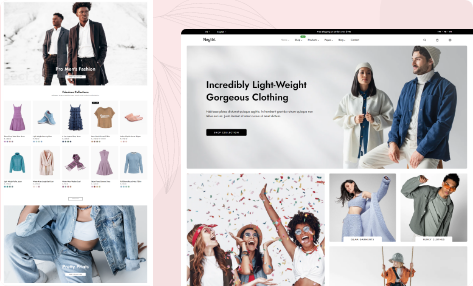[vc_row][vc_column][vc_column_text]
Why Conversion Rate Optimization (CRO) is important for your website

Every month, you have a significant volume of website visitors. You should be thrilled, but there’s a major issue. None of your website visitors is converting or taking action on your site. Nobody subscribes to your email list or makes a transaction from you.
Conversion Rate Optimization (CRO) strategies might be used as a solution. When utilized appropriately, it may assist you in better understanding the most important customers of all, which are your website users.
What is meant by conversion rate?
A conversion rate is the number of visitors who complete an action on your site. A conversion rate can encompass a wide variety of goals depending on the purpose of your site.
For example, if you are an eCommerce site, your conversion rate would involve the number of individuals who make a purchase. In contrast, if you run a blog, your main goal is to get as many subscribers as possible. Therefore, before trying any CRO strategies, it’s essential to define your goals with your site.
How to find out the conversion rate of your website?
You can determine your current conversion rate after knowing what you’re trying to solve. You may achieve this by dividing the number of conversions by site visits and multiplying the result by 100.
Let us assume that you earned 30 sales and had 1000 visits last month. To get, divide your number of sales (30) by the number of visitors (1,000). Take 03 and multiply it by 100 to achieve a 3% conversion rate.
Remember that the average conversion rate varies by industry and website topic. Because conversion rates might vary greatly, it’s crucial not to get too focused on a single figure.

What is Conversion Rate Optimization (CRO)?
The practice of improving the number of visitors who take action on your website is referred to as conversion rate optimization (CRO). CRO is about much more than just coming up with test concepts. A well-defined CRO strategy analyses the user journey on your site, including what is either influencing or discouraging consumers from taking action.
CRO provides several more advantages for your company. To begin with, you may reduce your client acquisition expenditures. Instead of spending money on attracting new website visitors, you may invest in those already engaged. You may improve your client’s lifetime value, trust, and overall happiness by improving the user experience on your website.
CRO is very important in this digital age where everything is customer-centric and website-driven.
Creating your CRO Strategy
Before you start to implement the strategies of CRO on your website. You need to find out where you need to use it and to what extent.
Defining Your Goals
Remember to choose a conversion target that is easy to assess when creating your conversion objectives. It is also beneficial to divide conversion objectives into macro and smaller goals. Your macro-objective is the last action you want people to perform, such as purchasing a product.
Micro conversion objectives are the minute actions consumers take before making a wide choice, such as browsing many pages on your site or viewing videos or images. Consider your niche and the anticipated actions users will take to define your micro-goals.
Who is the Target Audience?
Aside from seeing yourself in the shoes of your probable clients and considering what you would do before proceeding with the ultimate goal, you must also determine who your ideal potential consumer is. Here are some qualities you may combine to create your ideal.

Demographics
Knowing the customer demographics makes it easier for you to fulfil their needs. You may learn about your consumers’ gender, age, education level, income level, job title, and location using internet analytics tools.
Interests
You’ll also want to know what’s upsetting your clients’ attention. Find out what potential buyers are most interested in and what doesn’t evoke any response from them at all.
Behaviors
Analyze the activities that people do on your site to determine user behaviour. Respond to the following questions:
- What pages are they visiting?
- How far down the page are they scrolling?
- Where will they be dropped off?
- How long does a site session last?
Again, web analytics tools can help you with this.
Because of the growing usage of the internet, the customer journey has changed in recent years. Here are some things to think about while planning your ideal customer experience.
Awareness
Customers nowadays become conscious of your website, products, or services through web research. They put an issue or inquiry into a search engine to find out additional information. Focus on developing informational material that delivers solutions to target consumers at this point. You might, for example, produce informative blog entries or make instructive films.
Considerations
A prospective customer knows their problem but seeks answers at this phase in the sales funnel. These clients aren’t ready to make a final decision, but giving relevant materials will assist push them in the right direction. You may pique this audience’s interest by providing materials such as downloadable manuals or booklets on your products or services.
Decision
When potential consumers are ready to make a final decision, they frequently want to know why they should choose you. Use case studies, papers, or blog entries to explain why your organization can resolve its issue. Only at this time, and only at this stage, should you utilize sales rhetoric.
Measurable Key Performance Indicators
To determine where your CRO initiatives should go, you’ll need to know which key performance indicators (KPIs) to monitor. The KPIs you select should be determined by the goals you specify. On the other hand, some KPIs are beneficial to any CRO plan, such as website traffic, the number of macro and micro conversions, revenue per visitor, and email subscriber growth rate.
Do An A/B and Multivariance Test
A/B and multivariate testing tools are two excellent options for determining your KPIs.
A/B testing involves pitting two variants against one another. For example, you may A/B test two different versions of your site with different CTA buttons to determine which one receives the most traffic.
On the other hand, multivariate testing evaluates numerous factors to obtain more findings. You can test two homepages with different headlines and pictures to see if your site is affected by more than one element.

Prioritize User Experience
CRO and user experience go hand in hand. If you provide an excellent user experience on your website, you will improve conversions. Examine your website for navigation ease, layout scheme, accessibility, and credibility.
Consider this: If you were a consumer on this website, would you feel comfortable making a purchase?
Comprehend User Behavior
A user’s experience on your site frequently defines a user’s behaviour. Look for trends on your site to better understand user activity. Consider the following:
Which pages are people leaving?
Is there a point in their trip where users give up immediately before making a purchase?
Create CTA Buttons for Conversions
Call to action (CTA) buttons are frequently deciding whether or not a user will complete a conversion. Approximately 90% of website visitors who glance at your title will also look at your CTA button, indicating that it is just as significant.
Ensure your CTA button is visible and not obscured by surrounding text or pictures. Make your material stand out by using contrasting colours and keeping it brief yet intriguing.
Use User Suggestions
Obtaining direct consumer input is another incredibly efficient form of conversion rate improvement. Sending out customer surveys or questionnaires through email to find the “why” behind consumers’ behaviours might help you collect feedback.
For improving your strategies, ask questions for your customers, such as:
- What drew them to your website?
- What about your products or services drew their attention?
- Was there anything on your website that made you hesitant?
Discover The Obstacles to Conversion
Receiving positive feedback can also assist in identifying conversion difficulties, such as the following:
Pages Loading Slowly
A delayed load time is one of the most common reasons visitors depart, as it provides a terrible user experience. Look into what variables may be causing one or more of your web pages to take longer to load than others. Overuse of flash material, too many advertisements, or unoptimized graphics are all common issues.
Bounce Rates Are Extremely High
There are several reasons why you may have a high bounce rate.
For instance, consumers may struggle to navigate your site, become distracted by flashing pictures, or struggle to find the content they want. High bounce rates present an excellent opportunity for A/B and multivariate testing.
Landing Pages with Poor Design
A badly designed landing page is chaotic, cluttered with material, difficult to read, or contains vague language. Remember that people expect information and solutions that are quick, efficient, and simple to grasp. Always choose basic over intricate and plain over dazzling.
How to Track Your Conversion Rate Optimization Success
Use metric-tracking tools and resources to guarantee that your CRO approach produces results.
You may be wondering how to measure what you put into action now that you have all of the information. Fortunately, the internet is rife with tools and information that may aid in the success of your CRO approach.
Google Analytics
Google Analytics is the best tool for assessing your CRO approach because it provides many indicators. You may view your website traffic, bounce rate, user demographics, site speed, marketing campaign statistics, and much more. Even better, Google provides a Google Analytics tutorial.
Measurable Key Performance Indicators
Which KPIs do you need to monitor? Here are a few to consider when measuring your CRO efforts.
Returning Customers
First, consider the quantity of new and returning clients. If you acquire many new clients, look for ways to entice former customers to return, such as by giving discounts. If you discover that you have more recurring clients, take another look at your web pages to see if any potential blockages are preventing unique users from visiting.
Bounce Rates
According to a LinkedIn survey, the average bounce rate for websites is 61 percent. However, keep in mind that what defines a “good” bounce rate is heavily dependent on the purpose of a website. If your site’s goal is to offer users information on a single page, a greater bounce rate is not always a bad thing.
Cost-Per-Conversion
You may calculate your cost-per-conversion if you want to focus more on the financial part of your CRO activities. Measuring this gives you an idea of how much it costs you to gain new clients. If you discover that your cost is too high, you might rethink your advertising efforts or focus on reaching a different audience.
Time Spent on Page
Finally, track how much time people spend on your website. Time spent on a page, like bounce rate, can indicate if your website content is beneficial and relevant to users. Examine your stuff again over a longer average time. Would you benefit from new types of material or a modification of your present work?

Why does it all Matter?
By undertaking CRO, you optimize the maximum potential of your website and deliver the best user experience possible. Furthermore, you spend more wisely since you focus your resources on quality prospects. Finally, CRO is the most profitable and beneficial technique to stand out from the crowd and create a place for delighted consumers. You may continue to improve your site’s success by experimenting with different CRO tactics over time.
We can Help!
Creating the perfect conversion rate optimization plan for your company requires study, work, and maintenance, but the benefits are well worth it. Fortunately, Silver Ant Marketing is here to assist you in getting started on your CRO journey. Our CRO strategists can help you become brand specialists and follow a full CRO scientific methodology. Contact us now to get started on changing your website.[/vc_column_text][/vc_column][/vc_row]
























